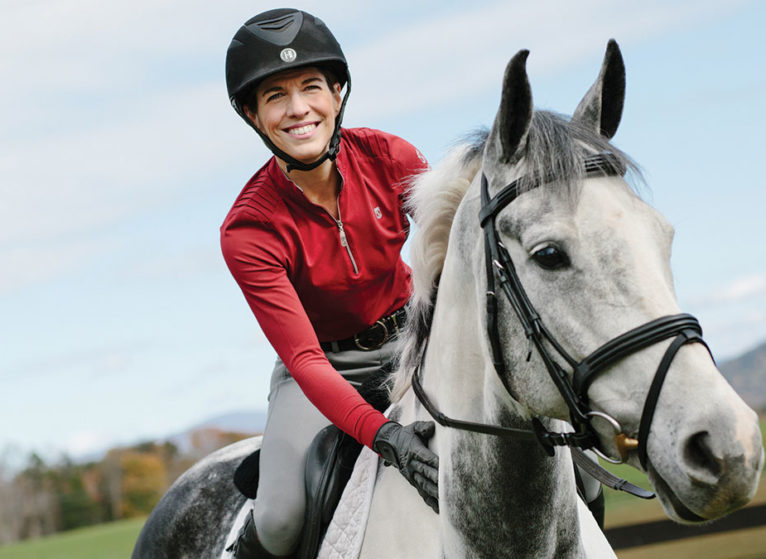I was 7 years old when I took my first horseback riding lesson. One of the very first things I learned? When you fall off, you have to get back on. And let me tell you, in the riding community, they don’t mean get back on tomorrow; they mean right now.
Of course, there are exceptions when serious injuries happen. But for the most part, that has been the expectation — some might even say tradition — for many, many generations of riders.
Old Traditions Meet New Data
Fast forward to 2021. Stephanie Bajo, PsyD, a lifelong rider and also a neuropsychologist at UVA Health, is hoping to change the “get-back-on” culture. She has looked at local emergency room visits to assess rates of concussion. One finding? A higher rate of concussions treated among horseback riders than football players and others in high impact sports.
Concussions need to be taken seriously, but with proper management, you can expect a full recovery. However, getting a second head injury right away can lead to slow recovery, and in rare cases, have devastating consequences. That’s why it’s critical to be honest about any symptoms following a fall.
Bajo has spoken to local equestrian groups to provide concussion education and to encourage them to rethink how they treat falls. The most important message? If you fall off a horse and hit your head or have any symptoms of concussion, you should get checked by a medical professional before you ride again and risk another fall.
Here’s her advice for riders, parents, and trainers.
Learn Concussion Symptoms
Be familiar with the symptoms of concussion:
- Headache
- Ringing of the ears
- Nausea or vomiting
- Drowsiness
- Blurred vision

Check the Rider After a Fall
Don’t encourage riders to get right back on after a fall if:
- They have hit their head.
- They didn’t hit their head but experience concussion symptoms. You can get a concussion even without hitting your head.
After a fall, follow Bajo’s recommendations:
- If the rider hit their head and has symptoms: Contact their primary care provider. The rider should not get back on until the provider says it’s okay.
- If the rider has severe symptoms: They should be evaluated at an emergency room. The rider should not get back on until they have been evaluated and cleared.
- If the rider hit their head and doesn’t have symptoms: Avoid getting back on that day. But if the rider remains symptom-free, then it is unlikely they have a concussion. They can go about their riding schedule as usual.
- If the rider didn’t hit their head and doesn’t have symptoms: It is unlikely they experienced a concussion. They can get back on and ride as usual.
Bajo also says, if in doubt, it’s always good to check with your primary care provider.
Wear an Approved Riding Helmet
Bajo encourages riders of all disciplines to always wear an ASTM-approved helmet while riding. It’s a good idea to wear a helmet even when handling horses on the ground, she says.
Always replace a helmet after a head-impact fall, or once the helmet reaches the end of its recommended use. That’s typically 5 years, but check with your helmet manufacturer.

Changing the Helmet Culture
Western horseback riding disciplines traditionally don’t wear helmets. But Bajo points out that neither did other equestrian disciplines in the past. Now many of those equestrian disciplines require them. She hopes that all equestrians will normalize helmet use.
“Change within a culture takes time. But if enough individuals have the knowledge of the risks and take action to address them, the norms around helmet use can also change,” she says. “I would encourage riders in all disciplines to learn about the consequences of riding without a helmet, especially the increased risk of skull fracture, and to remind themselves of these risks every time they ride."
As a rider, Bajo understands this advice represents a shift for the equestrian community, and she doesn’t discount that. But she says that the data talks, and the data says it’s time to reconsider some of those old traditions.



I had an incident as a child in the late 60s. I feel off a pony headfirst and his hoof made contact w the side of my head.
I had a concussion but noone knew until almost too late. Yep had all the symptoms.
First was taken to family doc then taken to ER.
They had to drill a hole to relieve the pressure. First on one side later on the other.
I was partially paralyzed on the right side and still have weakness now. I would say I have 98% use.
God blessed my parents and I very much. That things didn’t turn out worse.
You are welcome to use my story or contact me.
Oh Gwyn, that sounds absolutely awful. I am so glad that you got medical attention in time. Thank you for reading, and for sharing your story.
I have worked in construction most of my life. At age 61, I fell on a job site and experienced a traumatic brain injury.
My wife and I also ride horses and have experienced a number of riders in the Western and trail riding discipline who will not wear helmets. We have ridden in numerous states and Canada. I want to ride into the sunset!
In our construction company we talk about managing our risk, in fact I would guess most businesses manage their risk in numerous ways. I believe wearing my helmet is one way to manage my risk and it just may allow me to ride many more mountain trails until I can no longer pull myself into my saddle. Thank you for sharing this article. I hope it is well received.
Hi Jim, thank you so much for your response. I think that’s a fabulous way to think about it, and I certainly agree. Happy trails to you!